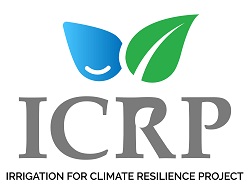ICRP: Disclosure of ESIA Documents for Matanda Irrigation Scheme
ICRP: Disclosure of ESIA Documents for Matanda Irrigation Scheme

The Irrigation for Climate Resilience Project (ICRP) aims to support the shift towards more resilient agriculture through the development of sustainable irrigation services. Access to irrigation is critical to allow farmers coping with climate variability, to increase yield and intensification, and diversify towards higher value crops. The project will address Uganda’s climate change vulnerabilities by: (i) promoting adoption of irrigation by smallholder farmers, in synergy with other agriculture inputs and technologies; (ii) increasing water storage capacity; and (iii) promoting sustainable catchment management. This change will be market-driven, with irrigation becoming the anchor for stronger producer organizations and development of value chains.
ICRP: Disclosure of ESIA Documents for Matanda Irrigation Scheme
The Government of Uganda through the Ministry of Water and Environment with support from the World Bank is to construct the Matanda Multipurpose Irrigation Project, located on River Kiruruma in Kanungu District, Southwestern Uganda. Matanda Irrigation Scheme project shall be constituted by three components, i.e., the dam (water reservoir), main pipeline, and the irrigable command area.
Irrigation Development and Climate Resilience Project (P163836)
Environmental and Social Management Framework (ESMF)
Updated May 2024
IRRIGATION FOR CLIMATE RESILIENCE PROJECT (ICRP) SECTIONAL RESETTLEMENT ACTION PLAN (RAP) FOR KABUYANDA IRRIGATION NETWORK, ISINGIRO DISTRICT ADDENDUM NO. 3 TO THE RAP FOR KABUYANDA IRRIGATION SCHEME PUBLISHED ON FEBRUARY 18, 2019
Ministry of Water and Environment
Irrigation for Climate Resilience Project (ICRP)
Terms of Reference for Environmental and Social Impact Assessment (ESIA) for the Construction of Amagoro Irrigation scheme in Tororo District
TERMS OF REFERENCE FOR STAKEHOLDERS ENGAGEMENT IN MATANDA IRRIGATION SCHEME (KANUNGU DISTRICT)
During the ICRP negotiations in February 2020, the GoU through MWE and the World Bank agreed on the opportunity of implementation of the Resettlement Action Plan (RAP) reflecting the sectioning of large civil works and agreed that the various plans could be implemented in sections, provided that this is adequately reflected in the RAPs approved and agreed with the World Bank and that a RAP completion report will be produced for each such section. With reference to the Kabuyanda irrigation
The proposed Kabuyanda dam is designed for storage of streamflow, which will limit the water flow and may also possibly alter water quality in the R. Mishumba downstream of the dam. The estimated monthly runoff for R. Mishumba at the proposed dam location indicates a bi-modal variation with two peak flows in April and October of 0.8m³/s and 0.89m³/s, respectively, and a mean annual flow is 0.51m³/s. Based on available data, the river sometimes dries up in the dry months of July and August, and February and September.
During project preparation, a Resettlement Action Plan (RAP) for the Kabuyanda Irrigation scheme was prepared, consulted upon, cleared by the World Bank, and disclosed on the MWE website on February 18, 2019 (https://www.mwe.go.ug/projects/ICRP) and on the World
(https://documents.worldbank.org/en/publication/documentsreports/document...)
“The Resettlement Policy Framework (RPF)’ has been prepared as an instrument to be used throughout the Irrigation Development and Climate Resilience Project implementation. The RPF will be disclosed to set out the resettlement and compensation policy, organizational arrangements and design criteria to be applied to meet the needs of the people who may be affected by the program. The Resettlement Action Plan (RAPS) for the Irrigation Development and Climate Resilience Project will be prepared in conformity with the provisions of this RPF.
Ministry of Water & Environment
Plot 3 - 7 Kabalega Crescent Road, Luzira
P.O. Box 20026 Kampala, Uganda
Tel : +256 417 889 400
Email: mwe@mwe.go.ug
Website: www.mwe.go.ug














